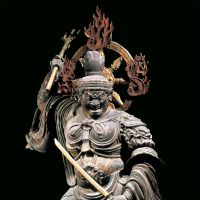The Japanese Buddhist monk Kukai, commonly known as Kobo Daishi, traveled across China in the early 800s as an envoy to study esoteric Buddhism. After bringing the fruits of his learnings back to Japan, he later helped found Shingon as one of the main forms of Buddhism in the country.
The early period of Shingonism heavily emphasized the arts as a means to spread the often difficult teachings of Buddhism. This practice manifested itself in ritual articles, statues, headpieces and mandalas, many of which are on display in this show along with scripts written by Kukai himself and other objects from the Tang Dynasty in China (618-906).
This exhibit showcases 99 pieces from the early Shingon period in Japan, the majority of which have been designated National Treasures by the Japanese government. It is a rare exhibition that was made possible through the participation of the Jingoji, Toji and numerous other temples in Kyoto where many of the works are usually kept; till Sept. 25.
Tokyo National Museum Heiseikan; (03) 5777-8600; 13-9 Ueno Park, Taito-ku; 10-min walk from Ueno Station, JR lines. 9:30 a.m.-5 p.m. (Fri.. till 8 p.m., Sat. & Sun., till 6 p.m.). ¥1,500. Closed Mon. www.tnm.jp.



















With your current subscription plan you can comment on stories. However, before writing your first comment, please create a display name in the Profile section of your subscriber account page.